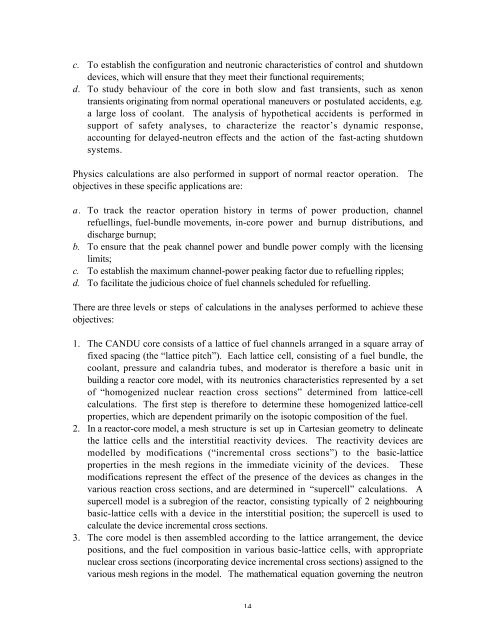Physics Codes and Methods for CANDU Reactor by ... - Basic Search
Physics Codes and Methods for CANDU Reactor by ... - Basic Search
Physics Codes and Methods for CANDU Reactor by ... - Basic Search
Create successful ePaper yourself
Turn your PDF publications into a flip-book with our unique Google optimized e-Paper software.
c. To establish the configuration <strong>and</strong> neutronic characteristics of control <strong>and</strong> shutdowndevices, which will ensure that they meet their functional requirements;d. To study behaviour of the core in both slow <strong>and</strong> fast transients, such as xenontransients originating from normal operational maneuvers or postulated accidents, e.g.a large loss of coolant. The analysis of hypothetical accidents is per<strong>for</strong>med insupport of safety analyses, to characterize the reactor’s dynamic response,accounting <strong>for</strong> delayed-neutron effects <strong>and</strong> the action of the fast-acting shutdownsystems.<strong>Physics</strong> calculations are also per<strong>for</strong>med in support of normal reactor operation. Theobjectives in these specific applications are:a. To track the reactor operation history in terms of power production, channelrefuellings, fuel-bundle movements, in-core power <strong>and</strong> burnup distributions, <strong>and</strong>discharge burnup;b. To ensure that the peak channel power <strong>and</strong> bundle power comply with the licensinglimits;c. To establish the maximum channel-power peaking factor due to refuelling ripples;d. To facilitate the judicious choice of fuel channels scheduled <strong>for</strong> refuelling.There are three levels or steps of calculations in the analyses per<strong>for</strong>med to achieve theseobjectives:1. The <strong>CANDU</strong> core consists of a lattice of fuel channels arranged in a square array offixed spacing (the “lattice pitch”). Each lattice cell, consisting of a fuel bundle, thecoolant, pressure <strong>and</strong> cal<strong>and</strong>ria tubes, <strong>and</strong> moderator is there<strong>for</strong>e a basic unit inbuilding a reactor core model, with its neutronics characteristics represented <strong>by</strong> a setof “homogenized nuclear reaction cross sections” determined from lattice-cellcalculations. The first step is there<strong>for</strong>e to determine these homogenized lattice-cellproperties, which are dependent primarily on the isotopic composition of the fuel.2. In a reactor-core model, a mesh structure is set up in Cartesian geometry to delineatethe lattice cells <strong>and</strong> the interstitial reactivity devices. The reactivity devices aremodelled <strong>by</strong> modifications (“incremental cross sections”) to the basic-latticeproperties in the mesh regions in the immediate vicinity of the devices. Thesemodifications represent the effect of the presence of the devices as changes in thevarious reaction cross sections, <strong>and</strong> are determined in “supercell” calculations. Asupercell model is a subregion of the reactor, consisting typically of 2 neighbouringbasic-lattice cells with a device in the interstitial position; the supercell is used tocalculate the device incremental cross sections.3. The core model is then assembled according to the lattice arrangement, the devicepositions, <strong>and</strong> the fuel composition in various basic-lattice cells, with appropriatenuclear cross sections (incorporating device incremental cross sections) assigned to thevarious mesh regions in the model. The mathematical equation governing the neutron14
















